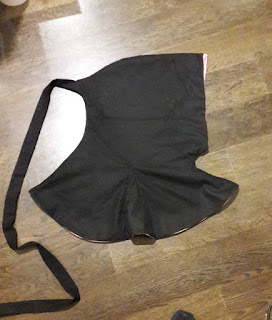As announced in court at Baronial Anniversary, this year we will be running a Baronial A&S Challenge. The terms of the challenge are set out below.
Each entrant must complete five projects that each meet the requirements of at least one distinct category of the thirty available. The projects must be begun after Baronial Anniversary 2017, and completed by Baronial Anniversary 2018. Projects must be submitted to the A&S Officer – summaries and photographs as appropriate, reviews of comestibles/potables by consumers and performances by those present etc. Submissions/progress submissions will be featured on this blog by the A&S officer throughout the Challenge, if approved by the submitter. Spot prizes/awards will occur throughout the challenge, and successful completion of the Challenge by Baronial Anniversary 2018 will earn a special token from their Excellencies’ hands at that event. There will be a special display of projects as they are at that point during the A&S Display at next Canterbury Faire, and a display of the available projects at Baronial Anniversary 2018.
For any who are not members of the populace of Southron Gaard, please note that her Excellency has decided this Challenge is also open to entry from those not resident in our fair Barony, as it is not your fault that you are so disadvantaged.
Projects may meet more than one category, but each one must meet at least one distinct category. Shared projects may count towards the Challenge for all participants.
Categories:
1. Child’s Play
Any item intended for a child – clothing, accessory, toy, game, wrap, cradle etc
2. Out of Your Comfort Zone
An item from a time or place or material or skill set you have not previously explored
3. Hitting Below The Knee
An item intended for use below the knee
4. The Neck Best Thing
An item intended for use on, around, or above the neck
5. Here Be Monsters
An item featuring or incorporating fantastical mediaeval beasts and creatures.
6. For Science!
Arts and Science often focuses a lot on the Arts side. Make a project that is more related to the Sciences.
7. Show Us Your Arms
A project of heraldic display.
8. Break A Leg
A performance based project – learn a new dance, sing a song, do a performance etc.
9. Tool Me Once
A project to make a tool to be used in other projects (not necessarily for the Challenge).
10. Cover Me
A project to make an item intended for protection: from the elements, from other people who want to hit or poke you etc. Suggestions include: wet weather gear, armour, tents and shelters
11. String Theory
A project significantly incorporating some form of string – weaving, knitting, ropes, nets, knots etc
12. One Metre Material Project
A project made of less than one linear metre of fabric, wood or other material that usually comes in larger quantities.
13. Century Time Traveller
A project from exactly 500, 600, 700, 800 years etc in the past. Make something from in period, from a year ending in 17.
14. Back To Basics
Ever wanted to undertake a sheep to clothing project? Mine your own clay for bricks and build an oven? This is your opportunity. This project will be made as much as possible from unprocessed elements, from the beginning to the end product.
15. Those Who Can, Also Teach
Pass on your knowledge! Present an A&S class or run an A&S activity outside of Canterbury Faire or activities you usually run, or write an informative article for an SCA publication or similar.
16. Give What You Get
A project to be given to the Barony or Kingdom (check they would like it first!), or to be given to Their Excellencies or Their Majesties to be given out as largesse, or as a gift for a relative newcomer.
17. I Can’t Believe It’s Not Out Of Period
A project that includes accurately documenting something often erroneously considered naff, out of period or otherwise wrong for the SCA.
18. Tis the Season
A project specifically related to a particular season or Saint’s day or holiday.
19. Embellish It
A project to add embellishment or decoration to an already existing item
20. With The Grain
A project featuring grains – of wheat, of rice, of paradise or any other grain
21. Fly The Colours
A project based on the primary Baronial colours – Red, White and Gold.
22. Oh Say, Can You Sea?
A project related to the high seas – something nautical, related to ships, made of shells or pearls etc
23. Togs, Togs, Undies
An item that could be considered an under thing. Or an item of clothing intended for a specific purpose: eg, swimming, cooking, hunting, hawking, sports.
24. Remake, Reuse, Refashion, Reconsider
A project to remake or complete an item you or someone else has previously made, or halfmade and abandoned.
25. Containment System
A project to make something designed to hold other things – boxes, bags etc.
26. Forget Me Not
A project related to death/mourning. Memento mori, mourning clothing or traditions etc.
27. Counting (on) Sheep
Ovines were significant to medieval life – providing meat, milk, wool and the imagery of lambs. Incorporate one into a project.
28. Fire Burns
A project using real fire. Cook on it, forge with it, make it in a period manner.
29. A Bird In The Hand
Of or relating to birds – feathered accessories, quills, roasted birds, raising chickens, falconry projects etc
30. An Essay Of A Thousand Words
Research and write an essay on an aspect of medieval life. Topic of your choice, minimum of a thousand words.











